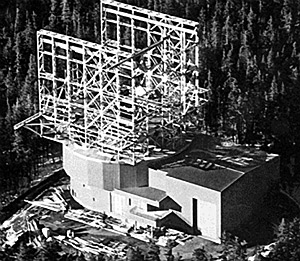 |
|
FILE PHOTO/Arizona Daily Wildcat
|
The Mount Graham telescope will be dedicated Friday despite being incomplete. The construction of the telescope has been opposed by local Native American tribes due to its location on holy grounds atop the mountain.
|
|
|
By Natasha Bhuyan
Arizona Daily Wildcat
Wednesday, October 13, 2004
Print this
The UA will host the official dedication ceremony Friday for the Large Binocular Telescope on Mount Graham, a project both hailed and criticized by people across the nation.
Although the telescope is not complete, representatives from institutions who have invested in the LBT will tour the Mirror Lab in the Steward Observatory, followed by the dedication at the Westin La Paloma Resort, said Ann Spitz, special assistant to the director at Steward Observatory.
When completed, the $120 million telescope will be equipped with two 8.4-meter honeycomb mirrors that will permit high definition observation of faint stars and galaxies by combining light from the mirrors, said Bruno Marano, a professor of astronomy at the Universitą di Bologna in Italy.
Adaptive optics secondary mirrors will provide a built-in capability of correcting atmospheric turbulence, resulting in sharper images, said Marano, who will attend the ceremony Friday.
"LBT will see deeper into space than the Hubble Space Telescope and, for the very first time, see planets revolving around planets in other solar systems," said Jim Slagle, assistant director and program manager of LBT from UA.
But not everyone is lauding the LBT and other telescope projects on Mount Graham.
For nearly two decades, the telescopes have been the subject of controversy due to their location atop Mount Graham, a site which the local San Carlos and White Mountain Apache Native American tribes consider sacred.
"It's been long, hard work...a struggle," said Michael Davis, executive director for the Apache Survival Coalition and part of the San Carlos Apache tribe. "But we will continue to oppose all the activity on Mount Graham."
Environmental groups across the country have also opposed the telescopes, claiming the mountain has more ecological diversity than any mountain in the United States.
Dwight Metzger, a long-time activist with the Mount Graham Coalition, said in its quest to secure prestige, the UA has used its political power to desecrate a holy site by being the first university to challenge Native American religious rights in a court of law.
In 1996, Congress exempted the Mount Graham telescopes from the Endangered Species Act, the Environmental Policy Act and the American Indian Religious Freedom Act, Metzger said.
"If the UA had properly followed the national environmental law, there wouldn't have been that many problems," Davis said. "But they don't follow the law - they run to Congress for exemptions."
The telescope project was conceived in the mid-1980s and UA officials originally expected to see first light in 1992, said Dr. Robert Witzeman, conservation chair of the Maricopa Audubon Society. However, Witzeman said the project has faced years of delay due to insufficient funds and partner institutions backing away from the controversial endeavor.
First light is the first instance a telescope produces strong, astronomically useful images.
Slagle said LBT's early photos and initial tests are better than expected, but Witzeman said the project is 12 years behind schedule.
"It must be terribly embarrassing they are getting their first 8-meter mirror in now," Witzeman said. "There is a real cultural and moral issue in the telescopes."
Students at other institutions involved in the project, such as the University of Minnesota and the University of Virginia, have also protested the telescopes, due to the cultural, financial, and environmental issues.
Guy Lopez, a Ph.D. candidate in anthropology and linguistics at the University of Virginia, said the telescope project, which was once titled the "Columbus Project" but later changed as the name further offended tribes, is shameful to higher education.
"While the U of A claims that they've officially dropped the name, the 'Columbus Project' moniker still speaks for their mindset...if they had it their way, they would turn the top of Mount Graham into a Columbus theme park," Lopez said.
Although touted by UA officials as potentially the largest telescope in the world, Witzeman said when completed, the LBT will only be the third largest, after the European Southern Observatory in Chile and the Keck Observatory in Hawaii.
According to the European Southern Observatory Web site, the Very Large Telescope in Chile will have four 8-meter mirrors with an aperture of 16 meters, while LBT's aperture is 11.8 meters.
UA astronomers defended the telescope, pointing out the numerous benefits the LBT will contribute to science as well as the Tucson community.
Spitz said ground-based telescopes and space exploration are linked in the quest to understand the solar system, as LBT scientists will produce research that complements space-based telescopes.
Additionally, UA students who work with research professors will have a chance to access such projects, Spitz said.
"LBT is a multimillion dollar project that brings jobs - engineering and other technical areas, scientists and support positions - to the Tucson area," Spitz said.
Slagle said the UA will produce "cutting-edge science," embarking on a journey of discovery with the premier scientists of the world.
"Because it is in Arizona rather than space, we will do this exploration in a more cost-effective manner," Slagle said. "We will offer our students a chance to study data from a telescope that is unique in this world ... It doesn't get any better."
The second mirror will be placed on the telescope in 2005, and second light is scheduled for 2006, Spitz said.
The LBT is expected to be fully operational by 2007, with both mirrors installed and producing images.
